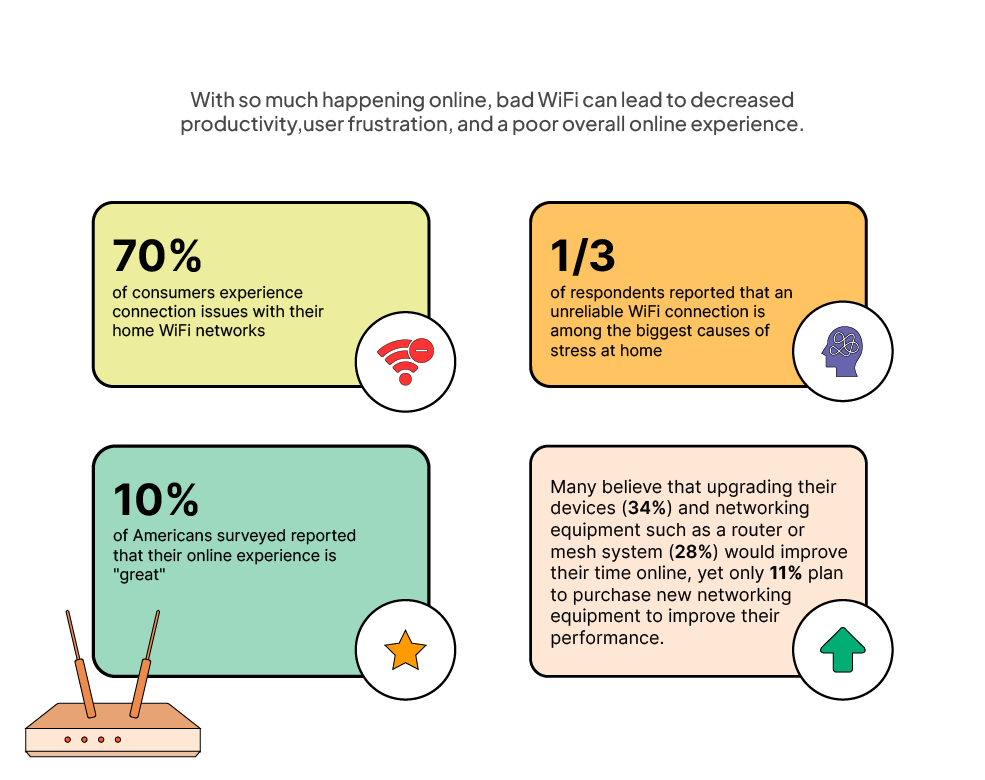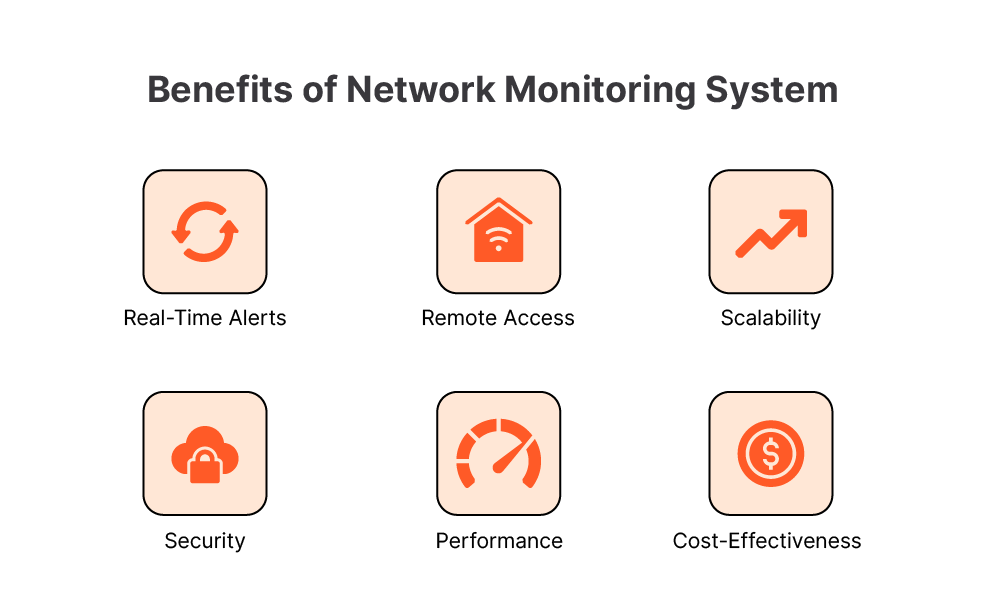Did you know Wi-Fi, a technology crucial to our always-connected world, is already 30 years old? Yet, how we manage the networks behind it feels stuck in the past. Imagine relying on flip-flops to run a marathon – that’s what manual network management is like for Internet Service Providers (ISPs) today. It’s slow, cumbersome, and prone to errors.
This is where automation comes in. By proactively taking care of their networks with automation tools, ISPs can ensure they remain reliable, efficient, and meet the ever-growing demands of their customers. In this blog, we’ll explore the benefits of network automation for ISPs, their challenges, and some exciting future trends that will transform network management.
Challenges you face with manual network management
Relying on old-school management of networks is like trying to run a marathon in flip-flops. It’s slow, cumbersome, and full of hurdles that will trip you up when least expected. Let’s look at some challenges you might face and how they can affect your Internet Service Provider (ISP) business.
1. Spending too much time on configurations and maintenance
When managing your network manually, each device requires individual configuration. Think about the hours you will need to spend setting up and adjusting settings for hundreds of new residential subscribers. To manually configure each subscriber individually will take a significant portion of your team’s time each month.
As the network expands, so does your workload. Relying on manual processes will impact your ability to rapidly adapt to the changing demands of the digital landscape. This reliance on manual processes will impact your competitiveness in the market by limiting your ability to respond quickly to customer needs.
2. Battling human error every step of the way
One of the biggest concerns with managing a network manually is dealing with the constant fear of human error. Even the most skilled professionals are prone to make mistakes, and a single misconfiguration could cost a fortune—leading to a catastrophic outage. Disruptions of service damage your reputation, and you know it. Attempting to minimize these errors can be stressful and weigh heavily on your team—impacting morale and productivity.
3. Struggling to keep your customers happy
At the end of the day, your customers are the ones who feel the impact of any network issues. Downtime and service delays can be frustrating, especially in today’s digital age, where connectivity is everything. In a competitive market, a customer who is unhappy with your services may not hesitate to switch to a provider with more reliable services. Manual network management not only affects your customer satisfaction but also threatens customer retention and loyalty.
Here is what our customers are going through:

4. Inefficiency in scaling network infrastructure
Manual network management can pose significant challenges when it comes to scaling your network infrastructure to meet growing demands. As your customer base expands or technology evolves, manually configuring and expanding your network becomes increasingly complex and time-consuming. Each new device or service requires careful configuration and integration into the existing network architecture, leading to bottlenecks and delays in service delivery. This inefficiency in scaling can hinder your ability to quickly adapt to market trends or customer demands, ultimately impacting your competitiveness and growth potential.
5. Limited visibility and control
Another challenge of manual network management is the limited visibility and control over network performance and security. Without automated monitoring and analytics tools, it’s challenging to gain real-time insights into network traffic, performance metrics, and security threats. This lack of visibility makes it difficult to proactively identify and address issues, leaving your network vulnerable to downtime, cyber attacks, and performance bottlenecks. Additionally, manual processes for tracking network inventory and device health may lead to inaccuracies or oversights, further compromising network reliability and resilience.
These challenges highlight the limitations and risks associated with manual network management. As we explore the benefits of automation in the next section, you’ll discover how embracing automation can address these challenges and unlock new opportunities for your ISP business.
Top 10 automation ideas for ISPs
1. Network configuration management
When you automate network configuration management, you simplify the process of setting up devices like routers and switches. Instead of manually configuring each device, you can use pre-built templates and specialized tools to speed up the process. This ensures that all devices are configured consistently across your network, reducing the likelihood of errors that could cause issues later on. Moreover, automation makes it easier to scale your network as needed, enabling seamless expansion without compromising efficiency.
Here are some key features of automated network configuration:
- Create visual maps of your network, highlighting new/modified devices and configuration errors.
- Save current settings and allow them to be restored to the same or similar devices.
- Track device changes, aiding troubleshooting and preventing unauthorized modifications.
- Ensure configurations meet security and regulatory standards (FISMA, SOX, HIPAA, etc.).
2. Network monitoring and alerting
Automated monitoring systems continuously monitor your network for any abnormalities or issues. These systems promptly alert you to any problems, allowing you to address them immediately. By receiving alerts before problems escalate, you can ensure uninterrupted service for your customers, enhancing their satisfaction. Automated monitoring and notification help you maintain the reliability and performance of your network, minimizing downtime and maximizing uptime.

3. Maintenance and updates
Automating maintenance and updates allows you to keep your network devices up-to-date without disrupting services. You can schedule updates to occur during off-peak hours, minimizing disruption to users. This ensures that the network remains secure and compliant with regulations while minimizing any inconvenience for your customers. Automated maintenance and updates streamline operations, enabling efficient management of network infrastructure without compromising service quality.
4. Customer self-service
Offering online self-service tools and chatbots empowers customers to manage their accounts and services independently. This reduces the workload for your support team and enhances customer satisfaction. With self-service options, customers can perform tasks such as bill payments and service changes at their convenience, improving their overall experience with your ISP.
5. Optimizing network performance
Automating network performance optimization allows you to dynamically adjust bandwidth and traffic shaping to meet the needs of your customers in real-time. This ensures that your network can handle varying demands without experiencing slowdowns or interruptions. By optimizing network performance, you can deliver a seamless experience for your customers, enhancing their satisfaction and loyalty.
6. Reporting and analytics
Automated reporting and analytics provide valuable insights into the health and performance of your network. By identifying trends and potential issues early on, you can proactively address them before they affect service quality. Additionally, automated reports save time and facilitate data-driven decision-making, enabling you to optimize network operations and support business growth.
7. Security automation
Automated security systems continuously monitor your network for suspicious activity and respond to threats in real-time. This helps protect your network from cyber-attacks and ensures compliance with regulations. By automating security tasks, you can maintain a secure environment without requiring extensive expertise or resources, enhancing the overall resilience of your network.
8. Network inventory management
Automating network inventory management allows you to track all your devices efficiently. By monitoring device health and identifying issues early, you can prevent downtime and ensure reliable service for your customers. Automated inventory management streamlines operations, improves accuracy, and enhances the overall reliability of your network infrastructure.
9. Compliance management
Automating compliance management ensures that your network meets regulatory standards and requirements. By automating processes, you can avoid errors and ensure compliance without manual intervention. This helps maintain the security and integrity of your network while minimizing the risk of regulatory violations.
10. Disaster recovery
Automating disaster recovery plans lets you quickly restore your network after a disruption. By backing up data and having a recovery plan, you can minimize downtime and maintain customer service availability. This protects your reputation and reduces financial losses associated with network outages.
Bonus: Field service management software for automation
Field Service Management (FSM) software also plays a crucial role in automating ISP operations, including service scheduling, dispatching, and resource management. FSM software offers automation features such as:
Streamline your field service with Zuper’s powerful features:
- Automated Scheduling: Optimizes service schedules based on technician availability, location, and skillset, ensuring efficient allocation of resources and timely service delivery.
- Dispatch Automation: Assigns service tasks to field technicians automatically, considering proximity to the job site and workload, improving response times and maximizing technician productivity.
- Mobile Workforce Management: Provides mobile applications for field technicians to access job details, update work status, and capture customer information in real-time, streamlining communication and improving productivity.
- Workflow Automation: Automates repetitive tasks and workflows, such as generating work orders, sending appointment reminders, and processing service requests, reducing manual effort and minimizing errors.
The future of network automation
Are you curious about what’s next in network automation? Let’s explore some exciting trends that could transform the way you manage networks:
AI and Machine Learning (ML) for network management:
Gartner predicts by 2024 that 40% of network troubleshooting tasks will be automated using AI. This means faster solutions and better network performance. With AI, you can analyze lots of network data to spot patterns, predict issues, and fix problems automatically. This lets you focus on important tasks while keeping your network running smoothly.
The rise of software-defined networking (SDN):
Traditionally, making network changes was slow and complicated because settings were tied to hardware. SDN changes that by separating the control (brain) of the network from the hardware (body). This makes managing networks easier and faster. By 2027, the SDN market could be worth $38.81 Billion, showing how popular this technology is becoming. With SDN, you can automate setting up networks, delivering services, and keeping everything secure, making your work more efficient.

Network Function Virtualization (NFV):
NFV builds on SDN by taking virtualization further. It lets you run network functions like firewalls and load balancers on virtual machines instead of dedicated hardware. This saves money on equipment and gives you more flexibility. By 2027, the NFV market might reach $53.04 Billion, highlighting its growing importance. With NFV, you can quickly set up network services, adjust to changing needs, and offer new services faster.
These trends, along with better automation tools, promise a future where network management is:
- Networks can solve problems before they cause trouble.
- You can adapt to changes and offer new services quickly.
- Automation saves time and money.
- AI and ML can spot and stop security threats.
By embracing these changes, you can create networks that are more efficient, flexible, and secure. You can be a key partner in helping businesses and people succeed in the digital world.
Benefits of network automation for ISPs
1. Cost reduction
Network automation significantly reduces operational costs for ISPs by minimizing manual labor and streamlining processes. Automated provisioning, configuration management, and maintenance tasks eliminate the need for extensive human intervention, thereby reducing labor costs associated with manual network management. Additionally, automation optimizes resource utilization, leading to cost savings in terms of hardware, software, and energy consumption.
2. Enhanced efficiency
Automation improves operational efficiency by accelerating tasks that would otherwise be time-consuming and error-prone if performed manually. With automated workflows and processes in place, ISPs can achieve faster deployment of network services, quicker resolution of issues, and more efficient resource allocation. This not only increases productivity but also allows ISPs to deliver services more promptly and effectively, enhancing overall operational efficiency.
3. Superior customer experience
Network automation plays a crucial role in enhancing the customer experience by improving service quality, reliability, and responsiveness. Automated monitoring and alerting systems enable ISPs to proactively detect and address network issues before they impact customers, minimizing downtime and service disruptions. Additionally, automation enables the implementation of self-service portals and chatbots, empowering customers to manage their accounts and resolve issues independently, thereby enhancing satisfaction and loyalty.
4. Overcoming challenges
While the benefits of network automation are significant, ISPs must acknowledge and address certain challenges associated with its implementation. One such challenge is the initial investment required to deploy automation solutions and infrastructure. Additionally, acquiring and retaining skilled personnel with expertise in automation technologies may pose a challenge for some ISPs. However, with strategic planning, investment, and training programs, these hurdles can be overcome, enabling ISPs to realize the full potential of network automation.
5. Strategic planning and investment
To successfully leverage the benefits of network automation, ISPs must engage in strategic planning and investment. This involves conducting a thorough assessment of existing processes, identifying areas where automation can be implemented effectively, and developing a roadmap for deployment. Additionally, ISPs must invest in the necessary infrastructure, tools, and technologies to support automation initiatives. By aligning automation strategies with business objectives and investing in the right resources, ISPs can maximize the return on investment and unlock the full potential of network automation.
6. Brighter future with automation
Despite the challenges, network automation holds the promise of a brighter future for ISPs. By embracing automation technologies and practices, ISPs can achieve significant cost savings, improve operational efficiency, and deliver superior customer experiences. With the right strategic planning, investment, and commitment to overcoming challenges, network automation can revolutionize the way ISPs operate, paving the way for a more agile, resilient, and competitive industry landscape.
Conclusion
In an era defined by digital innovation, ISPs must embrace automation to thrive in the competitive landscape. By leveraging automation solutions, ISPs can revolutionize their operations, delivering unparalleled reliability, efficiency, and customer satisfaction. The journey towards automation may pose challenges, but the rewards are well worth the investment. Let us embark on this transformative path, ushering in a new era of network management powered by automation.





